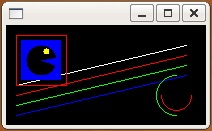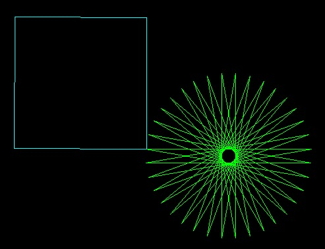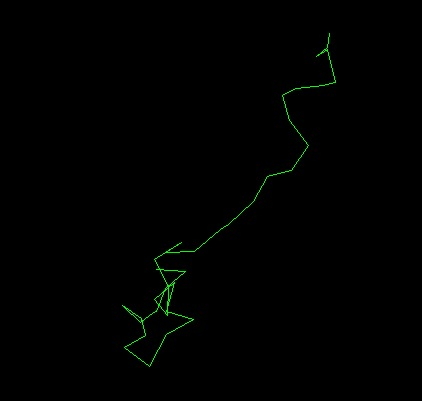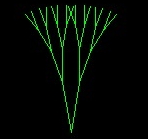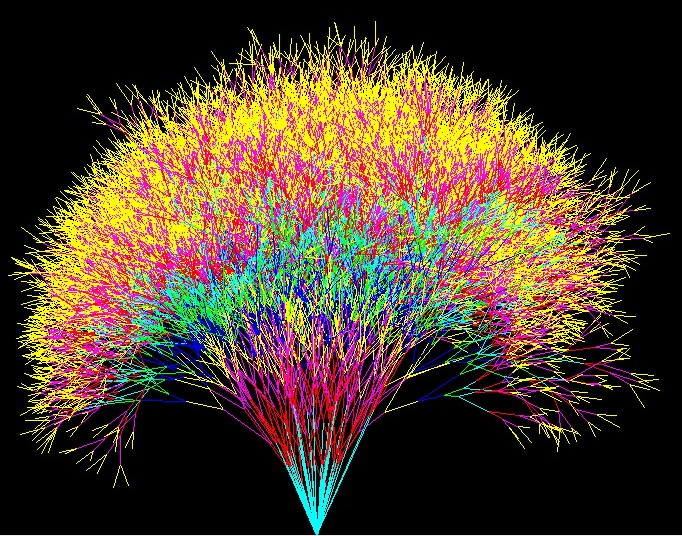Here are a couple super-useful web pages that explains most of what I needed to know about X-Windows:
1) The X Window system (includes a short tutorial and the Xlib manual) http://tronche.com/gui/x/
2) Basic Graphics Programming With The Xlib Library - by Guy Keren http://www.silverhawk.net/notes/tutorials/x/x2.html
Refer to them when you write your own programs.
=================== Example 1 ===================
// xwindow_example.c
// This program opens a graphics window and draw four lines: white, red, green and blue.
// Then it draws a green half-circle, and a red half-circle
// Then a red square, a blue filled square and lastly a black filled arc, and a yellow filled circle.
// This xwindow example was made possible by the helpful information and example written by
// Christophe Tronche http://tronche.com/
//
// Please check out the tutorial that Mr. Tronche has posted here:
// http://tronche.com/gui/x/xlib-tutorial/2nd-program-anatomy.html
// I also used information from another good tutorial which ie here:
// http://user.xmission.com/~georgeps/documentation/tutorials/Xlib_Beginner.html
// Compile command: It must use C++ because the x-window graphics library is in C++
// g++ -Wall -W -Werror xwindow_example.c -o xwindow_example -lX11
// Compile command for Apple OSX only:
// g++ -Wall -W -Werror xwindow_example.cpp -o xwindow_example -I/usr/X11R6/include -L/usr/X11R6/lib -lX11
// (On the mac the headers amd libraries are in non-standard places.)
// After you compile it, this is the command to run it: ("./" means "here". Linux runs whatever it finds.)
// ./xwindow_example
#include <X11/Xlib.h> // Every Xlib program must include this
#include <assert.h> // I include this to test return values the lazy way
#include <unistd.h> // So we got the profile for 10 seconds
#include <stdio.h> // This has the keyboard and file IO functions
#define NIL (0) // A name for the void pointer
int main()
{
char keyboard_input[100];
GC gc; //This will be the "graphics context" It remembers the colors and window and various details.
XColor black_col,white_col,red_col,green_col,blue_col,yellow_col;
Colormap colormap;
char black_bits[] = "#000000";
char white_bits[] = "#FFFFFF";
char red_bits[] = "#FF0000";
char green_bits[] = "#00FF00";
char blue_bits[] = "#0000FF";
char yellow_bits[] = "#FFFF00";
Display *dpy = XOpenDisplay(NIL); assert(dpy); // Open the display
// Get the only two predefined colors in xwindows: Black and White
int blackColor = BlackPixel(dpy, DefaultScreen(dpy));
//int whiteColor = WhitePixel(dpy, DefaultScreen(dpy));
// Define the colors we want to use
colormap = DefaultColormap(dpy, 0);
XParseColor(dpy, colormap, black_bits, &black_col); XAllocColor(dpy, colormap, &black_col);
XParseColor(dpy, colormap, white_bits, &white_col); XAllocColor(dpy, colormap, &white_col);
XParseColor(dpy, colormap, red_bits, &red_col); XAllocColor(dpy, colormap, &red_col);
XParseColor(dpy, colormap, green_bits, &green_col);XAllocColor(dpy, colormap, &green_col);
XParseColor(dpy, colormap, blue_bits, &blue_col);XAllocColor(dpy, colormap, &blue_col);
XParseColor(dpy, colormap, yellow_bits, &yellow_col);XAllocColor(dpy, colormap, &yellow_col);
// Create the window The numbers are the x and y locations on the screen, the width and height,
// border width (which is usually zero)
Window w = XCreateSimpleWindow(dpy, DefaultRootWindow(dpy), 0, 0, 200, 100, 0, blackColor, blackColor);
XSelectInput(dpy, w, StructureNotifyMask); // We want to get MapNotify events
XMapWindow(dpy, w); // "Map" the window (that is, make it appear on the screen)
for(;;){XEvent e; XNextEvent(dpy,&e); if(e.type == MapNotify) break;} //Wait for the MapNotify event
// which means that the window has appeared on the screen.
gc = XCreateGC(dpy, w, 0, NIL); // Create a "Graphics Context"
// We are finally ready to do some drawing! Whew!
// Lets try XDrawLine(display, d, gc, x1, y1, x2, y2)
XSetForeground(dpy, gc, red_col.pixel); // Tell the GC we draw using the RED color
XDrawLine(dpy, w, gc, 10, 70, 180, 30); // Draw theline
XSetForeground(dpy, gc, green_col.pixel); // Tell the GC we draw using the GREEN color
XDrawLine(dpy, w, gc, 10, 80, 180, 40); // Draw the line
XSetForeground(dpy, gc, blue_col.pixel); // Tell the GC we draw using the BLUE color
XDrawLine(dpy, w, gc, 10, 90, 180, 50); // Draw the line
//XSetForeground(dpy, gc, whiteColor); // Tell the GC we draw using the WHITE color (Method 1)
XSetForeground(dpy, gc, white_col.pixel); // Tell the GC we draw using the WHITE color (Method 2)
XDrawLine(dpy, w, gc, 10, 60, 180, 20); // Draw the line
// Lets try XDrawArc(display, d, gc, x, y, width, height, angle1, angle2)
// The angle are in weird units of 1/64th of a degree. angle1 is the start angle. (Zero is to the right.)
// angle2 is how much of an arc to make.
XSetForeground(dpy, gc, green_col.pixel); // Tell the GC we draw using the GREEN color
XDrawArc(dpy, w, gc, 150, 50, 40, 40, 90*64, 180*64); // Draw the arc
XSetForeground(dpy, gc, red_col.pixel); // Tell the GC we draw using the RED color
XDrawArc(dpy, w, gc, 155, 55, 30, 30, 180*64, 180*64); // Draw the arc
// Lets try XDrawRectangle(display, d, gc, x, y, width, height)
XSetForeground(dpy, gc, red_col.pixel); // Tell the GC we draw using the RED color
XDrawRectangle(dpy, w, gc, 10, 10, 50, 50); // Draw the rectangle
// Lets try XFillRectangle(display, d, gc, x, y, width, height)
XSetForeground(dpy, gc, blue_col.pixel); // Tell the GC we draw using the BLUE color
XFillRectangle(dpy, w, gc, 15, 15, 40, 40); // Draw the filled rectangle
// Lets try XFillArc(display, d, gc, x, y, width, height, angle1, angle2)
// The angle are in weird units of 1/64th of a degree. angle1 is the start angle. (Zero is to the right.)
// angle2 is how much of an arc to make.
XSetForeground(dpy, gc, black_col.pixel); // Tell the GC we draw using the BLACK color
XFillArc(dpy, w, gc, 20, 20, 30, 30, 10*64, 330*64); // Draw the filled arc
XSetForeground(dpy, gc, yellow_col.pixel); // Tell the GC we draw using the YELLOW color
XFillArc(dpy, w, gc, 37, 23, 6, 6, 0*64, 360*64); // Draw the filled circle
XFlush(dpy); // Tell the graphics server that it should really show us the results now.
sleep(1); // Wait for 1 second
printf("Press enter when done.\n");
fgets (keyboard_input,100,stdin);
return(0);
}
=================== Example 2 ===================
// turtle_graphics_example.c
// This program creates an easy way for students to make beautiful patterns, via the turtle graphics metaphore.
// The turtle has a pen on its tail. As he moves, he leaves a line behind him.
// The turtle commands are forward, left, right, home, pen_up (no line), pen_down (line),
// and get_pen (select a color).
// Students: go down to the bottom of the example, and you'll see where you can create your own patterns.
// As-is, this program opens a graphics window and the turtle draws a green star and a cyan colored square.
// This xwindow example was made possible by the helpful information and example written by
// Christophe Tronche http://tronche.com/
//
// Please check out the tutorial that Mr. Tronche has posted here:
// http://tronche.com/gui/x/xlib-tutorial/2nd-program-anatomy.html
// I also used information from another good tutorial which ie here:
// http://user.xmission.com/~georgeps/documentation/tutorials/Xlib_Beginner.html
// Compile command: It must use C++ because the x-window graphics library is in C++
// g++ -Wall -W -Werror turtle_graphics_example.c -o turtle_graphics_example -lX11
// After you compile it, this is the command to run it: ("./" means "here". Linux runs whatever it finds.)
// ./turtle_graphics_example
#include <X11/Xlib.h> // Every Xlib program must include this
#include <assert.h> // I include this to test return values the lazy way
#include <unistd.h> // So we got the profile for 10 seconds
#include <stdio.h> // This has the keyboard and file IO functions
#include <math.h> // sine, cosine and various math functions
#include <stdbool.h> // Defines true, false
#define NIL (0) // A name for the void pointer
#define window_width 800
#define window_height 600
#define origin_x 400
#define origin_y 300
GC gc; //This will be the "graphics context" It remembers the colors and window and various details.
Display *dpy;
Window w;
double turtle_x; double turtle_y; double turtle_heading; //heading is in degrees. zero is to the right.
bool turtle_pen_active = true;
int home() {
turtle_x=0.0; turtle_y=0.0; turtle_heading=0.0;
return(0);
}
int forward(double distance) {
double new_x=turtle_x+distance*cos(turtle_heading*M_PI/180.0);
double new_y=turtle_y+distance*sin(turtle_heading*M_PI/180.0);
int x1=turtle_x+origin_x;
int y1=window_height-(turtle_y+origin_y);
int x2=new_x+origin_x;
int y2=window_height-(new_y+origin_y);
if (turtle_pen_active) XDrawLine(dpy, w, gc, x1, y1, x2, y2); // Draw theline
turtle_x=new_x;turtle_y=new_y;
return(0);
}
int right(double angle) { turtle_heading = turtle_heading-angle; return (0); }
int left(double angle) { turtle_heading = turtle_heading+angle; return (0); }
int get_pen(XColor desired_col) {
XSetForeground(dpy, gc, desired_col.pixel); // Tell the GC we draw using the desired color
return(0);
}
int pen_up() {turtle_pen_active = false; return(0); }
int pen_down() {turtle_pen_active = true; return(0); }
int main()
{
char keyboard_input[100];
XColor black_col,white_col,red_col,green_col,blue_col,yellow_col,magenta_col,cyan_col;
Colormap colormap;
char black_bits[] = "#000000";
char white_bits[] = "#FFFFFF"; // Mix red, green and blue to get white
char red_bits[] = "#FF0000";
char green_bits[] = "#00FF00";
char blue_bits[] = "#0000FF";
char yellow_bits[] = "#FFFF00"; // Mix red and green to get yellow
char magenta_bits[] = "#FF00FF"; // A sort of purple color
char cyan_bits[] = "#00FFFF"; // A blue-green color
//Display *dpy = XOpenDisplay(NIL);
dpy = XOpenDisplay(NIL); assert(dpy); // Open the display
// Define the colors we want to use
colormap = DefaultColormap(dpy, 0);
XParseColor(dpy, colormap, black_bits, &black_col); XAllocColor(dpy, colormap, &black_col);
XParseColor(dpy, colormap, white_bits, &white_col); XAllocColor(dpy, colormap, &white_col);
XParseColor(dpy, colormap, red_bits, &red_col); XAllocColor(dpy, colormap, &red_col);
XParseColor(dpy, colormap, green_bits, &green_col);XAllocColor(dpy, colormap, &green_col);
XParseColor(dpy, colormap, blue_bits, &blue_col);XAllocColor(dpy, colormap, &blue_col);
XParseColor(dpy, colormap, yellow_bits, &yellow_col);XAllocColor(dpy, colormap, &yellow_col);
XParseColor(dpy, colormap, magenta_bits, &magenta_col);XAllocColor(dpy, colormap, &magenta_col);
XParseColor(dpy, colormap, cyan_bits, &cyan_col);XAllocColor(dpy, colormap, &cyan_col);
// Create the window The numbers are the x and y locations on the screen, the width and height,
// border width (which is usually zero)
w = XCreateSimpleWindow(dpy, DefaultRootWindow(dpy), 0, 0, window_width, window_height,
0, black_col.pixel, black_col.pixel);
XSelectInput(dpy, w, StructureNotifyMask); // We want to get MapNotify events
XMapWindow(dpy, w); // "Map" the window (that is, make it appear on the screen)
for(;;){XEvent e; XNextEvent(dpy,&e); if(e.type == MapNotify) break;} //Wait for the MapNotify event
// which means that the window has appeared on the screen.
gc = XCreateGC(dpy, w, 0, NIL); // Create a "Graphics Context"
get_pen(white_col);
// We are finally ready to do some drawing! Whew!
// ................ Students: you put your beautiful code HERE: .......................
int i;
home(); // Send the turtle to the middle of the window. That's its "home"
get_pen(green_col);
for (i=0; i<36; i++) {
forward(250);
//printf("1 x=%g y=%g heading=%g\n",turtle_x,turtle_y,turtle_heading); //Optional: use for debugging
right(170);
//usleep(100000); XFlush(dpy); // Optional: use this to see the lines being drawn, one-by-one
}
pen_up(); home();
left(90); pen_down();
for (i=0; i<4; i++) {
get_pen(cyan_col);
forward(200);
//printf("2 x=%g y=%g heading=%g\n",turtle_x,turtle_y,turtle_heading); //Optional: use for debugging
left(90);
}
XFlush(dpy); // Tell the graphics server that it should really show us the results now.
sleep(1); // Wait for 1 second
printf("Press enter when done.\n");
fgets (keyboard_input,100,stdin);
return(0);
}
=================== Example 3 ===================
// drunken_turtle.c
// This example introduces a new turtle command: gotoxy
// Take a look at how it works. You will see that creating new commands is pretty easy.
// This example also introduces random numbers and how to create them. Note that computers can't
// make truly random numbers, so the time of the program's start is used as a random starting point
// for a pseudo-random sequence. Its random enough that you'll never know the difference.
// This xwindow example was made possible by the helpful information and example written by
// Christophe Tronche http://tronche.com/
// Please check out the tutorial that Mr. Tronche has posted here:
// http://tronche.com/gui/x/xlib-tutorial/2nd-program-anatomy.html
// I also used information from another good tutorial which ie here:
// http://user.xmission.com/~georgeps/documentation/tutorials/Xlib_Beginner.html
// Compile command: It must use C++ because the x-window graphics library is in C++
// g++ -Wall -W -Werror drunken_turtle.c -o drunken_turtle -lX11
// After you compile it, this is the command to run it: ("./" means "here". Linux runs whatever it finds.)
// ./drunken_turtle
#include <X11/Xlib.h> // Every Xlib program must include this
#include <assert.h> // I include this to test return values the lazy way
#include <unistd.h> // So we got the profile for 10 seconds
#include <stdio.h> // This has the keyboard and file IO functions
#include <math.h> // sine, cosine and various math functions
#include <stdbool.h> // Defines true, false
#include <time.h> // I need this because I will use the time to "seed" the random function
#include <stdlib.h> // I need this because it has the random functions
#define NIL (0) // A name for the void pointer
#define window_width 800
#define window_height 600
#define origin_x 400
#define origin_y 300
double rand_range(double fMin, double fMax)
{
double f = (double)rand() / RAND_MAX;
return fMin + f * (fMax - fMin);
}
GC gc; //This will be the "graphics context" It remembers the colors and window and various details.
Display *dpy;
Window w;
double turtle_x; double turtle_y; double turtle_heading; //heading is in degrees. zero is to the right.
bool turtle_pen_active = true;
int home() {
turtle_x=0.0; turtle_y=0.0; turtle_heading=0.0;
return(0);
}
int gotoxy (double new_x, double new_y) {
int x1=turtle_x+origin_x;
int y1=window_height-(turtle_y+origin_y);
int x2=new_x+origin_x;
int y2=window_height-(new_y+origin_y);
if (turtle_pen_active) XDrawLine(dpy, w, gc, x1, y1, x2, y2); // Draw theline
turtle_x=new_x;turtle_y=new_y;
return(0);
}
int forward(double distance) {
double new_x=turtle_x+distance*cos(turtle_heading*M_PI/180.0);
double new_y=turtle_y+distance*sin(turtle_heading*M_PI/180.0);
int x1=turtle_x+origin_x;
int y1=window_height-(turtle_y+origin_y);
int x2=new_x+origin_x;
int y2=window_height-(new_y+origin_y);
if (turtle_pen_active) XDrawLine(dpy, w, gc, x1, y1, x2, y2); // Draw theline
turtle_x=new_x;turtle_y=new_y;
return(0);
}
int right(double angle) { turtle_heading = turtle_heading-angle; return (0); }
int left(double angle) { turtle_heading = turtle_heading+angle; return (0); }
int get_pen(XColor desired_col) {
XSetForeground(dpy, gc, desired_col.pixel); // Tell the GC we draw using the desired color
return(0);
}
int pen_up() {turtle_pen_active = false; return(0); }
int pen_down() {turtle_pen_active = true; return(0); }
int main()
{
char keyboard_input[100];
XColor black_col,white_col,red_col,green_col,blue_col,yellow_col,magenta_col,cyan_col;
Colormap colormap;
char black_bits[] = "#000000";
char white_bits[] = "#FFFFFF"; // Mix red, green and blue to get white
char red_bits[] = "#FF0000";
char green_bits[] = "#00FF00";
char blue_bits[] = "#0000FF";
char yellow_bits[] = "#FFFF00"; // Mix red and green to get yellow
char magenta_bits[] = "#FF00FF"; // A sort of purple color
char cyan_bits[] = "#00FFFF"; // A blue-green color
//Display *dpy = XOpenDisplay(NIL);
dpy = XOpenDisplay(NIL); assert(dpy); // Open the display
// Define the colors we want to use
colormap = DefaultColormap(dpy, 0);
XParseColor(dpy, colormap, black_bits, &black_col); XAllocColor(dpy, colormap, &black_col);
XParseColor(dpy, colormap, white_bits, &white_col); XAllocColor(dpy, colormap, &white_col);
XParseColor(dpy, colormap, red_bits, &red_col); XAllocColor(dpy, colormap, &red_col);
XParseColor(dpy, colormap, green_bits, &green_col);XAllocColor(dpy, colormap, &green_col);
XParseColor(dpy, colormap, blue_bits, &blue_col);XAllocColor(dpy, colormap, &blue_col);
XParseColor(dpy, colormap, yellow_bits, &yellow_col);XAllocColor(dpy, colormap, &yellow_col);
XParseColor(dpy, colormap, magenta_bits, &magenta_col);XAllocColor(dpy, colormap, &magenta_col);
XParseColor(dpy, colormap, cyan_bits, &cyan_col);XAllocColor(dpy, colormap, &cyan_col);
// Create the window The numbers are the x and y locations on the screen, the width and height,
// border width (which is usually zero)
w = XCreateSimpleWindow(dpy, DefaultRootWindow(dpy), 0, 0, window_width, window_height,
0, black_col.pixel, black_col.pixel);
XSelectInput(dpy, w, StructureNotifyMask); // We want to get MapNotify events
XMapWindow(dpy, w); // "Map" the window (that is, make it appear on the screen)
for(;;){XEvent e; XNextEvent(dpy,&e); if(e.type == MapNotify) break;} //Wait for the MapNotify event
// which means that the window has appeared on the screen.
gc = XCreateGC(dpy, w, 0, NIL); // Create a "Graphics Context"
get_pen(white_col);
// We are finally ready to do some drawing! Whew!
// ................ Students: you put your beautiful code HERE: .......................
srand(time(NULL)); // Get ready to make random numbers. The time "seeds" the generator.
int i;
double x=0, y=0;
home(); // Send the turtle to the middle of the window. That's its "home"
get_pen(green_col); pen_down();
for (i=0; i<36; i++) {
x = x + rand_range(-30.0, 30.0); //Generates random number between these two numbers.
y = y + rand_range(-30.0, 30.0)+5.0;
gotoxy(x, y); // Move the turtle to the new location. It will draw a line if the pen is down.
XFlush(dpy); // Tell the graphics server that it should really show us the results now.
printf("1 x=%g y=%g heading=%g\n",turtle_x,turtle_y,turtle_heading); //Optional: use for debugging
usleep(100000); XFlush(dpy); // Optional: use this to see the lines being drawn, one-by-one
}
XFlush(dpy); // Tell the graphics server that it should really show us the results now.
sleep(1); // Wait for 1 second
printf("Press enter when done.\n");
fgets (keyboard_input,100,stdin);
return(0);
}
=================== Example 4 ===================
// turtle_tree.c
// This example introduces RECURSION. This means that a function calls itself.
// Imagine you could instantly create a copy of yourself. You could tell copy 1 to do your math homework
// and copy 2 to do your english homework.
// Then copy 1 copies itself. It tells copy 1-1 to do all the even math problems and copy 1-2 to do all the
// odd math problems and on and on.
// Soon you have hundreds of copies of yourself and the homework gets done really really fast! Wow!
// In this example, "branch" draws a couple sticks. But it wants more sticks at the end of each stick.
// So it copies itself and each copy draws more sticks! You'll see...
// Compile command: It must use C++ because the x-window graphics library is in C++
// g++ -Wall -W -Werror turtle_tree.c -o turtle_tree -lX11
// After you compile it, this is the command to run it: ("./" means "here". Linux runs whatever it finds.)
// ./turtle_tree
#include <X11/Xlib.h> // Every Xlib program must include this
#include <assert.h> // I include this to test return values the lazy way
#include <unistd.h> // So we got the profile for 10 seconds
#include <stdio.h> // This has the keyboard and file IO functions
#include <math.h> // sine, cosine and various math functions
#include <stdbool.h> // Defines true, false
#include <time.h> // I need this because I will use the time to "seed" the random function
#include <stdlib.h> // I need this because it has the random functions
#define NIL (0) // A name for the void pointer
#define window_width 800
#define window_height 600
#define origin_x 400
#define origin_y 300
double rand_range(double fMin, double fMax)
{
double f = (double)rand() / RAND_MAX;
return fMin + f * (fMax - fMin);
}
GC gc; //This will be the "graphics context" It remembers the colors and window and various details.
Display *dpy;
Window w;
double turtle_x; double turtle_y; double turtle_heading; //heading is in degrees. zero is to the right.
bool turtle_pen_active = true;
int home() {
turtle_x=0.0; turtle_y=0.0; turtle_heading=0.0;
return(0);
}
int gotoxy (double new_x, double new_y) {
int x1=turtle_x+origin_x;
int y1=window_height-(turtle_y+origin_y);
int x2=new_x+origin_x;
int y2=window_height-(new_y+origin_y);
if (turtle_pen_active) XDrawLine(dpy, w, gc, x1, y1, x2, y2); // Draw theline
turtle_x=new_x;turtle_y=new_y;
return(0);
}
int forward(double distance) {
double new_x=turtle_x+distance*cos(turtle_heading*M_PI/180.0);
double new_y=turtle_y+distance*sin(turtle_heading*M_PI/180.0);
int x1=turtle_x+origin_x;
int y1=window_height-(turtle_y+origin_y);
int x2=new_x+origin_x;
int y2=window_height-(new_y+origin_y);
if (turtle_pen_active) XDrawLine(dpy, w, gc, x1, y1, x2, y2); // Draw theline
turtle_x=new_x;turtle_y=new_y;
return(0);
}
int right(double angle) { turtle_heading = turtle_heading-angle; return (0); }
int left(double angle) { turtle_heading = turtle_heading+angle; return (0); }
int get_pen(XColor desired_col) {
XSetForeground(dpy, gc, desired_col.pixel); // Tell the GC we draw using the desired color
return(0);
}
int pen_up() {turtle_pen_active = false; return(0); }
int pen_down() {turtle_pen_active = true; return(0); }
//======================================================================================================
int branch(int depth) // This is a RECURSIVE dunction that will make a FRACTAL
{
printf("depth=%d\n",depth);
if (depth > 4) return(0); // The is the recursion ESCAPE route. Without it the program crashes.
depth++;
left(10); forward(100/depth); branch(depth); // branch is going to branch! How weird!
//usleep(100000); XFlush(dpy); // Optional: use this to see the lines being drawn, one-by-one
forward(-100/depth);
right(20); forward(100/depth); branch(depth); // branch will branch again! Weirder!
//usleep(100000); XFlush(dpy); // Optional: use this to see the lines being drawn, one-by-one
forward(-100/depth);
left(10);
return(0);
}
//======================================================================================================
int main()
{
char keyboard_input[100];
XColor black_col,white_col,red_col,green_col,blue_col,yellow_col,magenta_col,cyan_col;
Colormap colormap;
char black_bits[] = "#000000";
char white_bits[] = "#FFFFFF"; // Mix red, green and blue to get white
char red_bits[] = "#FF0000";
char green_bits[] = "#00FF00";
char blue_bits[] = "#0000FF";
char yellow_bits[] = "#FFFF00"; // Mix red and green to get yellow
char magenta_bits[] = "#FF00FF"; // A sort of purple color
char cyan_bits[] = "#00FFFF"; // A blue-green color
//Display *dpy = XOpenDisplay(NIL);
dpy = XOpenDisplay(NIL); assert(dpy); // Open the display
// Define the colors we want to use
colormap = DefaultColormap(dpy, 0);
XParseColor(dpy, colormap, black_bits, &black_col); XAllocColor(dpy, colormap, &black_col);
XParseColor(dpy, colormap, white_bits, &white_col); XAllocColor(dpy, colormap, &white_col);
XParseColor(dpy, colormap, red_bits, &red_col); XAllocColor(dpy, colormap, &red_col);
XParseColor(dpy, colormap, green_bits, &green_col);XAllocColor(dpy, colormap, &green_col);
XParseColor(dpy, colormap, blue_bits, &blue_col);XAllocColor(dpy, colormap, &blue_col);
XParseColor(dpy, colormap, yellow_bits, &yellow_col);XAllocColor(dpy, colormap, &yellow_col);
XParseColor(dpy, colormap, magenta_bits, &magenta_col);XAllocColor(dpy, colormap, &magenta_col);
XParseColor(dpy, colormap, cyan_bits, &cyan_col);XAllocColor(dpy, colormap, &cyan_col);
// Create the window The numbers are the x and y locations on the screen, the width and height,
// border width (which is usually zero)
w = XCreateSimpleWindow(dpy, DefaultRootWindow(dpy), 0, 0, window_width, window_height,
0, black_col.pixel, black_col.pixel);
XSelectInput(dpy, w, StructureNotifyMask); // We want to get MapNotify events
XMapWindow(dpy, w); // "Map" the window (that is, make it appear on the screen)
for(;;){XEvent e; XNextEvent(dpy,&e); if(e.type == MapNotify) break;} //Wait for the MapNotify event
// which means that the window has appeared on the screen.
gc = XCreateGC(dpy, w, 0, NIL); // Create a "Graphics Context"
get_pen(white_col);
// We are finally ready to do some drawing! Whew!
// ................ Students: you put your beautiful code HERE: .......................
home(); // Send the turtle to the middle of the window. That's its "home"
get_pen(green_col); pen_down();
left(90);
branch(1); //Draw the FRACTAL
XFlush(dpy); // Tell the graphics server to show us the results now.
sleep(1); // Wait for 1 second
printf("Press enter when done.\n");
fgets (keyboard_input,100,stdin);
return(0);
}
=================== Example 5 ===================
// turtle_tree2.c
// This example introduces RECURSION. This means that a function calls itself.
// Imagine you could instantly create a copy of yourself. You could tell copy 1 to do your math homework
// and copy 2 to do your english homework.
// Then copy 1 copies itself. It tells copy 1-1 to do all the even math problems and copy 1-2 to do all the
// odd math problems and on and on.
// Soon you have hundreds of copies of yourself and the homework gets done really really fast! Wow!
// In this example, "branch" draws a couple sticks. But it wants more sticks at the end of each stick.
// So it copies itself and each copy draws more sticks! You'll see...
// Compile command: It must use C++ because the x-window graphics library is in C++
// g++ -Wall -W -Werror turtle_tree2.c -o turtle_tree2 -lX11
// After you compile it, this is the command to run it: ("./" means "here". Linux runs whatever it finds.)
// ./turtle_tree2
#include <X11/Xlib.h> // Every Xlib program must include this
#include <assert.h> // I include this to test return values the lazy way
#include <unistd.h> // So we got the profile for 10 seconds
#include <stdio.h> // This has the keyboard and file IO functions
#include <math.h> // sine, cosine and various math functions
#include <stdbool.h> // Defines true, false
#include <time.h> // I need this because I will use the time to "seed" the random function
#include <stdlib.h> // I need this because it has the random functions
#define NIL (0) // A name for the void pointer
#define window_width 800
#define window_height 600
#define origin_x 400
#define origin_y 300
double rand_range(double fMin, double fMax)
{
double f = (double)rand() / RAND_MAX;
return fMin + f * (fMax - fMin);
}
GC gc; //This will be the "graphics context" It remembers the colors and window and various details.
Display *dpy;
Window w;
double turtle_x; double turtle_y; double turtle_heading; //heading is in degrees. zero is to the right.
bool turtle_pen_active = true;
int home() {
turtle_x=0.0; turtle_y=0.0; turtle_heading=0.0;
return(0);
}
int gotoxy (double new_x, double new_y) {
int x1=turtle_x+origin_x;
int y1=window_height-(turtle_y+origin_y);
int x2=new_x+origin_x;
int y2=window_height-(new_y+origin_y);
if (turtle_pen_active) XDrawLine(dpy, w, gc, x1, y1, x2, y2); // Draw theline
turtle_x=new_x;turtle_y=new_y;
return(0);
}
int forward(double distance) {
double new_x=turtle_x+distance*cos(turtle_heading*M_PI/180.0);
double new_y=turtle_y+distance*sin(turtle_heading*M_PI/180.0);
int x1=turtle_x+origin_x;
int y1=window_height-(turtle_y+origin_y);
int x2=new_x+origin_x;
int y2=window_height-(new_y+origin_y);
if (turtle_pen_active) XDrawLine(dpy, w, gc, x1, y1, x2, y2); // Draw theline
turtle_x=new_x;turtle_y=new_y;
return(0);
}
int right(double angle) { turtle_heading = turtle_heading-angle; return (0); }
int left(double angle) { turtle_heading = turtle_heading+angle; return (0); }
XColor black_col,white_col,red_col,green_col,blue_col,yellow_col,magenta_col,cyan_col;
int get_pen(XColor desired_col) {
XSetForeground(dpy, gc, desired_col.pixel); // Tell the GC we draw using the desired color
return(0);
}
int get_pen_n(int pen_number) {
switch (pen_number) {
case 0: get_pen(black_col); break;
case 1: get_pen(blue_col); break;
case 2: get_pen(green_col); break;
case 3: get_pen(cyan_col); break;
case 4: get_pen(red_col); break;
case 5: get_pen(magenta_col); break;
case 6: get_pen(yellow_col); break;
case 7: get_pen(white_col); break;
}
return(0);
}
int pen_up() {turtle_pen_active = false; return(0); }
int pen_down() {turtle_pen_active = true; return(0); }
//======================================================================================================
int branch(int depth) // This is a RECURSIVE dunction that will make a FRACTAL
{
double branch_length, branch_angle;
printf("depth=%d\n",depth);
if (depth > 10) return(0); // The is the recursion ESCAPE route. Without it the program crashes.
depth++;
get_pen_n(depth%6+1);
branch_length=rand_range(100,300)/depth;
branch_angle=rand_range(1,25);
left(branch_angle); forward(branch_length); branch(depth); // branch is going to branch! How weird!
//usleep(100000); XFlush(dpy); // Optional: use this to see the lines being drawn, one-by-one
forward(-branch_length); right(branch_angle);
branch_length=rand_range(100,300)/depth;
branch_angle=rand_range(1,25);
right(branch_angle); forward(branch_length); branch(depth); // branch will branch again! Weirder!
//usleep(100000); XFlush(dpy); // Optional: use this to see the lines being drawn, one-by-one
forward(-branch_length);
left(branch_angle);
get_pen_n((depth-1)%6+1);
return(0);
}
//======================================================================================================
int main()
{
char keyboard_input[100];
Colormap colormap;
char black_bits[] = "#000000";
char white_bits[] = "#FFFFFF"; // Mix red, green and blue to get white
char red_bits[] = "#FF0000";
char green_bits[] = "#00FF00";
char blue_bits[] = "#0000FF";
char yellow_bits[] = "#FFFF00"; // Mix red and green to get yellow
char magenta_bits[] = "#FF00FF"; // A sort of purple color
char cyan_bits[] = "#00FFFF"; // A blue-green color
//Display *dpy = XOpenDisplay(NIL);
dpy = XOpenDisplay(NIL); assert(dpy); // Open the display
// Define the colors we want to use
colormap = DefaultColormap(dpy, 0);
XParseColor(dpy, colormap, black_bits, &black_col); XAllocColor(dpy, colormap, &black_col);
XParseColor(dpy, colormap, white_bits, &white_col); XAllocColor(dpy, colormap, &white_col);
XParseColor(dpy, colormap, red_bits, &red_col); XAllocColor(dpy, colormap, &red_col);
XParseColor(dpy, colormap, green_bits, &green_col);XAllocColor(dpy, colormap, &green_col);
XParseColor(dpy, colormap, blue_bits, &blue_col);XAllocColor(dpy, colormap, &blue_col);
XParseColor(dpy, colormap, yellow_bits, &yellow_col);XAllocColor(dpy, colormap, &yellow_col);
XParseColor(dpy, colormap, magenta_bits, &magenta_col);XAllocColor(dpy, colormap, &magenta_col);
XParseColor(dpy, colormap, cyan_bits, &cyan_col);XAllocColor(dpy, colormap, &cyan_col);
// Create the window The numbers are the x and y locations on the screen, the width and height,
// border width (which is usually zero)
w = XCreateSimpleWindow(dpy, DefaultRootWindow(dpy), 0, 0, window_width, window_height,
0, black_col.pixel, black_col.pixel);
XSelectInput(dpy, w, StructureNotifyMask); // We want to get MapNotify events
XMapWindow(dpy, w); // "Map" the window (that is, make it appear on the screen)
for(;;){XEvent e; XNextEvent(dpy,&e); if(e.type == MapNotify) break;} //Wait for the MapNotify event
// which means that the window has appeared on the screen.
gc = XCreateGC(dpy, w, 0, NIL); // Create a "Graphics Context"
get_pen(white_col);
// We are finally ready to do some drawing! Whew!
// ................ Students: you put your beautiful code HERE: .......................
srand(time(NULL)); // Get ready to make random numbers. The time "seeds" the generator.
int i;
for (i=0; i< 20; i++) {
home(); // Send the turtle to the middle of the window. That's its "home"
get_pen(green_col); pen_up();
left(90);
forward(-300); pen_down();
branch(1); //Draw the FRACTAL
XFlush(dpy); // Tell the graphics server to show us the results now.
usleep(100000); // Wait for 100000 micro seconds
}
printf("Press enter when done.\n");
fgets (keyboard_input,100,stdin);
return(0);
}


